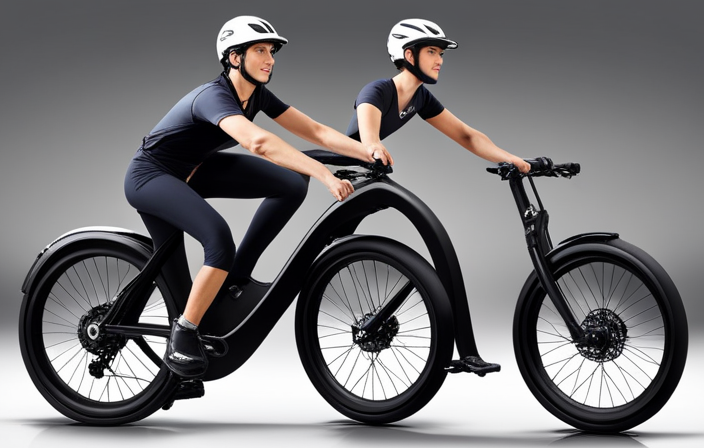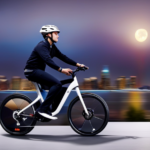Riding an electric assist bike is like having a gentle breeze at your back, propelling you effortlessly forward. These innovative bicycles combine the power of an electric motor with your pedaling efforts, providing a boost that makes uphill climbs a breeze and long distances seem shorter.
In this article, I’ll delve into the world of electric assist bikes, exploring their components, benefits, safety considerations, and more.
So, hop on and let’s embark on a thrilling ride through the exciting realm of electric assist bikes.
Key Takeaways
- Electric assist bikes are bicycles that are equipped with an electric motor to provide assistance to the rider while pedaling.
- The key components of an electric assist bike include the electric motor and battery, controller and sensors, and display and controls.
- Riding an electric assist bike offers benefits such as easier pedaling, longer range, and the ability to tackle hilly terrains more easily.
- There are different types of electric assist bikes available, including city bikes, mountain bikes, and folding bikes, with popular brands being Bosch, Shimano, and Yamaha.
Definition and Explanation of Electric Assist Bikes
If you’re not familiar with electric assist bikes, they’re bicycles that have a motor to help you pedal. These bikes are becoming increasingly popular among commuters and recreational riders alike.
The motor on an electric assist bike is usually located in the hub of the front or rear wheel, and it provides assistance when you pedal, making it easier to ride uphill or against strong headwinds.
One of the main benefits of riding an electric assist bike is that it allows you to go further and faster with less effort. It’s a great option for riders who may have physical limitations or want to extend their range.
In the next section, we’ll explore the components of an electric assist bike and how they work together to provide a smooth and efficient ride.
Components of an Electric Assist Bike
When it comes to electric assist bikes, there are several key components that make them function smoothly and efficiently.
The electric motor and battery work together to provide the necessary power to assist the rider’s pedaling.
The controller and sensors play a crucial role in monitoring the bike’s speed and pedal cadence, ensuring a seamless and responsive riding experience.
Lastly, the display and controls give the rider easy access to information such as battery life, speed, and assist levels, allowing for a customized and enjoyable ride.
Electric Motor and Battery
You can easily identify an electric assist bike by its electric motor and battery. The electric motor is the heart of the bike, providing power to assist the rider’s pedaling.
One important aspect to consider is the efficiency of the electric motor. High-efficiency motors convert a larger percentage of the energy from the battery into power for the bike, resulting in longer battery life and greater range.
The battery is responsible for storing and supplying power to the motor. It is crucial to estimate the battery range accurately, as it determines how far you can go before needing to recharge. Factors like terrain, rider weight, and assist level affect the battery range.
In the next section, we will delve into the controller and sensors, which work in tandem with the electric motor and battery to optimize the performance of the electric assist bike.
Controller and Sensors
The controller and sensors work together to optimize the performance of the e-bike. The controller is responsible for managing the flow of power from the battery to the electric motor. It ensures that the motor receives the right amount of power based on the rider’s input through the pedals or throttle. The controller also plays a crucial role in controlling the speed and acceleration of the e-bike.
Sensor placement is another important aspect of electric assist bikes. Sensors are strategically placed on the bike to collect data and provide feedback to the controller. For example, a torque sensor measures the force exerted by the rider and adjusts the motor power accordingly. The sensor placement is crucial for accurate readings and smooth operation of the e-bike.
Moving on to the next section about ‘display and controls’, these components provide the rider with information about the e-bike’s settings and allow them to adjust various parameters for a customized riding experience.
Display and Controls
The display and controls on an e-bike provide riders with information and the ability to customize their riding experience.
The display technology used on electric assist bikes has come a long way in recent years. Many e-bikes now feature high-resolution color displays that provide riders with real-time information such as speed, battery level, and distance traveled. These displays are easy to read, even in bright sunlight, and some even have built-in navigation systems.
The user interface is also user-friendly, with intuitive controls that allow riders to easily adjust settings such as pedal assist level and power output. Additionally, some e-bikes have advanced features like Bluetooth connectivity, allowing riders to connect their smartphones and access additional ride data or control features through an app.
The display and controls on an e-bike truly enhance the riding experience and make it more enjoyable and customizable.
Transitioning into the subsequent section about the ‘benefits of riding an electric assist bike’, riders can take full advantage of these features to have a more personalized and convenient riding experience.
Benefits of Riding an Electric Assist Bike
Riding an electric assist bike offers numerous benefits. One of the main advantages is that it allows me to ride longer distances with less effort. The electric motor provides an extra boost, making it easier to pedal uphill or against strong headwinds. This is especially helpful for people with limited physical fitness or those who want to conserve their energy for other activities.
Another benefit is the ability to commute to work without breaking a sweat. The electric assist allows me to arrive at my destination feeling fresh and ready to start the day. Additionally, electric assist bikes are a great option for those who want to reduce their carbon footprint and contribute to a cleaner environment.
Transitioning to the next section, let’s explore the different types of electric assist bikes available.
Types of Electric Assist Bikes
When it comes to choosing an electric assist bike, you have a variety of options to consider. Here are three types of e bike motors that are commonly found in electric assist bikes:
-
Hub motors: These motors are located in either the front or rear wheel hub and provide direct power to the wheel. They are known for their simplicity and durability.
-
Mid-drive motors: These motors are located in the center of the bike frame and provide power directly to the crankshaft. They offer better weight distribution and a more natural riding experience.
-
Friction drive motors: These motors use a roller that presses against the tire to provide power. They are lightweight and easy to install, but may have lower efficiency compared to other types.
When it comes to popular e bike brands, some well-known names in the industry include Trek, Specialized, and Giant.
Now, let’s move on to the next section and discuss safety considerations for electric assist bike riders.
Safety Considerations for Electric Assist Bike Riders
When it comes to riding an electric assist bike, there are several safety considerations that riders should keep in mind.
First and foremost, wearing a helmet and protective gear is essential to protect yourself in case of a fall or accident.
Additionally, it is important to familiarize yourself with traffic rules and regulations to ensure that you are riding safely and responsibly.
Lastly, proper battery management and maintenance is crucial to ensure the safe operation of your electric assist bike.
By following these safety guidelines, riders can enjoy a safe and enjoyable riding experience.
Helmet and Protective Gear
To ensure your safety while riding an electric assist bike, it’s important to wear a helmet and other protective gear. Here are three key items to consider:
-
Helmet safety: A properly fitting helmet is essential for protecting your head in case of a fall or collision. Make sure it meets safety standards and fits snugly on your head, with the chin strap securely fastened.
-
Protective gear importance: In addition to a helmet, wearing other protective gear such as knee and elbow pads, gloves, and reflective clothing can greatly reduce the risk of injury. These items provide added protection and increase visibility to other road users.
-
Stay visible and be cautious: Wearing bright, reflective clothing helps drivers see you better, especially during low-light conditions. Always ride defensively, obey traffic rules, and be aware of your surroundings.
By prioritizing helmet and protective gear and following traffic rules and regulations, you can enjoy a safe and enjoyable ride on your electric assist bike.
Traffic Rules and Regulations
Obeying traffic rules and regulations is crucial for ensuring a safe and enjoyable ride on your e-bike. Not only does it protect you, but it also promotes a harmonious coexistence with other road users. By following the rules, you contribute to reducing traffic congestion and making the roads safer for everyone. To emphasize the importance of traffic rules, let’s take a look at a table comparing electric assist bikes with other alternative transportation options:
| Electric Assist Bike | Bicycle | Car | |
|---|---|---|---|
| Speed | Up to 20 mph | 12 mph | Varies |
| Range | 20-50 miles | 10-20 miles | Varies |
| Cost | Low | Low | High |
As you can see, e-bikes offer a faster and more cost-effective way to travel short to medium distances. By choosing an e-bike and abiding by traffic rules, you can contribute to reducing traffic congestion and enjoying the benefits of alternative transportation options. Now let’s transition into the next section about battery management and maintenance.
Battery Management and Maintenance
Now that we have a good understanding of traffic rules and regulations for electric assist bikes, let’s dive into the important topic of battery management and maintenance.
As an electric bike enthusiast, I have learned that proper battery charging is crucial for maximizing the lifespan of the battery and ensuring optimal performance. It is essential to follow the manufacturer’s guidelines for charging, such as using the recommended charger and avoiding overcharging.
Additionally, troubleshooting common battery issues is something every electric bike owner should be familiar with. This includes checking for loose connections, keeping the battery clean and dry, and being aware of any unusual behavior or decline in battery performance.
By taking these steps, you can ensure that your electric assist bike’s battery remains in top shape.
Now, let’s move on to the next section where we will discuss choosing the right electric assist bike.
Choosing the Right Electric Assist Bike
When choosing the right electric assist bike, you should consider factors such as your desired level of assistance and the terrain you will be riding on. Electric assist bikes come in various types, including city bikes, mountain bikes, and folding bikes, each designed for different purposes.
City bikes are perfect for commuting on paved roads, while mountain bikes are built for off-road adventures. Folding bikes are convenient for those who need to transport their bike frequently. It’s important to choose a bike that suits your needs and preferences. Additionally, consider the battery range and charging time, as well as the motor power and assist levels. By taking these factors into account, you can find the perfect electric assist bike that will enhance your riding experience.
When it comes to maintenance and care tips for electric assist bikes, there are several steps you can take to keep your bike in optimal condition. [CONTINUE TO NEXT SECTION ON MAINTENANCE AND CARE TIPS]
Maintenance and Care Tips for Electric Assist Bikes
To keep your electric assist bike in optimal condition, it’s important to regularly clean and lubricate the moving parts. This will help prolong the life of your bike and ensure smooth operation.
Start by cleaning the frame and components with a mild detergent and water, being careful to avoid getting water on the electrical components. After cleaning, use a silicone-based lubricant on the chain, gears, and other moving parts to reduce friction and prevent rust.
Additionally, make sure to charge the battery regularly, following the manufacturer’s instructions. Troubleshooting common issues, such as a loss of power or a malfunctioning display, can often be resolved by checking the battery connections, ensuring proper tire pressure, and consulting the bike’s manual.
Taking these maintenance steps will keep your electric assist bike running smoothly for years to come.
Now, let’s delve into the legal regulations and restrictions for electric assist bikes.
Legal Regulations and Restrictions for Electric Assist Bikes
It’s important to be aware of the legal regulations and restrictions surrounding e-bikes. These regulations vary by country and even by state or province, so it’s crucial to understand the rules in your specific area. The legal requirements for electric assist bikes typically involve factors such as the maximum speed limit and the power output of the motor. For example, in the United States, e-bikes are generally classified as bicycles if they have a maximum speed of 20 mph and a motor with a power output of 750 watts or less. However, it’s important to note that these regulations can differ, so it’s essential to check with your local authorities to ensure compliance. Understanding the legal requirements will help you ride your e-bike safely and responsibly. Now, let’s transition into the next section, where we will compare electric assist bikes to other modes of transportation.
Comparison of Electric Assist Bikes to Other Modes of Transportation
Now that we have discussed the legal regulations and restrictions for electric assist bikes, let’s delve into how these bikes compare to other modes of transportation.
When comparing electric assist bikes to traditional bicycles, there are several key advantages. Electric assist bikes provide an extra boost of power, allowing riders to travel longer distances and tackle hills with ease. This makes them a great option for commuters who want to avoid arriving at their destination sweaty and exhausted.
Additionally, electric assist bikes offer a more environmentally friendly alternative to cars. They produce zero emissions and consume far less energy. Not only does this benefit the environment, but it also reduces our dependence on fossil fuels.
As we look towards future trends and innovations in electric assist bikes, it is clear that they are becoming increasingly popular and more advanced in terms of technology and design.
Future Trends and Innovations in Electric Assist Bikes
In the future, electric assist bikes are expected to see advancements in battery technology, allowing for longer and more efficient rides. These improvements will enable riders to travel greater distances without worrying about running out of power.
Additionally, the integration of artificial intelligence into electric assist bikes will enhance the overall riding experience, providing features such as adaptive assistance and personalized settings.
Furthermore, the growth of e-bike sharing programs will make electric assist bikes more accessible to a wider audience, promoting sustainable transportation and reducing reliance on traditional modes of transportation.
Advancements in Battery Technology
With advancements in battery technology, electric assist bikes have become more efficient and powerful. One major advancement is in charging technology, which has improved the charging speed and capacity of electric bike batteries. This means that riders can now charge their bikes more quickly and ride for longer distances without worrying about running out of power.
Additionally, advancements in battery technology have also led to a reduced impact on the environment. New battery designs are more energy-efficient and have a longer lifespan, reducing the need for frequent replacements and minimizing the amount of waste generated.
These advancements in battery technology are just one example of how electric assist bikes are evolving to meet the needs of riders. As we look ahead, the next exciting development is the integration of artificial intelligence into electric bikes.
Integration of Artificial Intelligence
Imagine riding your bike and having it automatically adjust its speed and power based on your riding style and the terrain you’re on, all thanks to the integration of artificial intelligence. This innovation has revolutionized the electric assist bike industry, enhancing the overall riding experience and safety. Artificial intelligence applications in electric bikes have allowed for real-time analysis of data collected from sensors, enabling the bike to make intelligent decisions and adapt to changing conditions. The table below highlights some of the key benefits and features of AI integration in electric assist bikes:
| Benefits | Features |
|---|---|
| Improved efficiency | Intelligent power management |
| Enhanced safety | Adaptive speed control |
| Customized riding experience | Terrain recognition |
| Optimal battery usage | Real-time data analysis |
The impact of artificial intelligence on transportation cannot be overstated. It has paved the way for smarter, more efficient modes of travel, including electric bikes. The integration of AI in electric assist bikes not only improves individual riding experiences but also contributes to the larger goal of sustainable and eco-friendly transportation. As we explore the growth of e-bike sharing programs, the advancements in AI technology continue to play a crucial role in shaping the future of transportation.
Growth of E-Bike Sharing Programs
Now that we’ve discussed the integration of Artificial Intelligence in electric assist bikes, let’s delve into the current subtopic: the growth of E-Bike Sharing Programs.
These programs have gained immense popularity in recent years, revolutionizing urban transportation. With the aim of reducing traffic congestion and promoting sustainable mobility, E-Bike Sharing Programs provide convenient and eco-friendly transportation options.
One of the most significant advantages of these programs is their positive environmental impact. By encouraging the use of electric bikes instead of traditional vehicles, they help reduce air pollution and carbon emissions. Additionally, E-Bike Sharing Programs often utilize renewable energy sources to charge their bikes, further minimizing their ecological footprint.
To add more depth to this discussion, let’s explore two subtopics within E-Bike Sharing Programs:
-
Accessibility: These programs aim to make electric bikes accessible to everyone, regardless of age or physical ability. They provide an affordable and convenient alternative to traditional bike ownership.
-
Infrastructure: E-Bike Sharing Programs often collaborate with cities to develop dedicated bike lanes and charging stations, creating a comprehensive infrastructure that supports sustainable transportation.
Overall, E-Bike Sharing Programs play a crucial role in promoting greener and more efficient urban mobility.
Frequently Asked Questions
How do electric assist bikes differ from regular bicycles?
Electric assist bikes differ from regular bicycles in that they have a motor that provides assistance while pedaling. This motor can be turned on or off, giving riders the option to choose when they want assistance. The benefits of electric assist bikes include easier uphill climbs, longer rides, and less physical exertion. However, they also have limitations such as limited battery life and the need for recharging.
Are there any age restrictions for riding an electric assist bike?
Age restrictions for riding an electric assist bike vary by location. In some areas, there may be minimum age requirements, usually around 16 years old. Additionally, individuals with physical disabilities may benefit from using electric assist bikes as they provide an extra boost of power.
Can I still ride an electric assist bike if I have a physical disability?
Yes, you can still ride an electric assist bike if you have a physical disability. Electric assist bikes provide benefits like easier pedaling and increased mobility, making them accessible for people with physical disabilities.
Are electric assist bikes allowed on bike lanes and trails?
Yes, electric assist bikes are generally allowed on bike lanes and trails. However, it’s important to note that there are safety concerns when sharing bike lanes with scooters due to speed differences and potential collisions.
Can I convert my regular bicycle into an electric assist bike?
Sure, you can convert your regular bicycle into an electric assist bike. The converting process involves adding a motor, battery, and controller. Electric assist bikes provide benefits such as easier pedaling, longer distances, and the ability to tackle hills effortlessly.
Conclusion
In conclusion, electric assist bikes are revolutionizing the way we travel and providing an environmentally friendly alternative to traditional modes of transportation.
With their ability to provide a boost to riders’ pedaling efforts, they make cycling more accessible and enjoyable for people of all fitness levels.
One interesting statistic is that sales of electric bikes in the United States have increased by over 70% in the past year alone, indicating a growing interest and demand for this innovative form of transportation.
As technology continues to advance, we can expect even more exciting developments in the world of electric assist bikes.
















